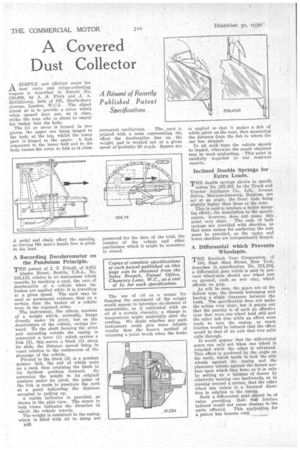A Covered Dust Collector
Page 62

If you've noticed an error in this article please click here to report it so we can fix it.
A Rjsurne of Recently Published Patent Specifications
A SIMPLE and efficient cover for dust carts and refuse-collecting wagons is described in Patent No. 338,400, by A. S. Fitch and J. A. McGillivray, both of 167, Shaftesbury Avenue, London, W.C.2. The object aimed at is to provide a cover which when opened does not, as it rises, strike the man who is about to empty his basket into the body.
The lid or cover is formed in two pieces, the upper one being hinged to the, body at the top, whilst the lower part is hinged to the upper. A link connected to the lower half and to the body causes the cover to fold as it rises.
A pedal and chain effect the opening, so leaving the man's hands free to pitch in his load.
A Recording Decelerorneter on the Pendulum Principle.
THE patent of J. T. Friedli. of 5,811 Alaska Street, Seattle, U.S.A., No. 338,115, relates to an instrument which records, by marking a card, the rate of deceleration of a vehicle when the brakes are applied while it is travelling at a given speed. The card may be used as permanent evidence that on a certain date the brakes of a vehicle were in the required order.
The instrument, like others, consists of a weight which, normally, hangs directly under its pivot, but on the deceleration of the vehicle, swings forward. To the shaft forming the pivot and extending outside the casing is connected a lever (1) which carries a link (2), this moves a block (3) along its slide, the distance moved being in exact relation to the suddenness of the stoppage of the vehicle.
Pivoted to the block (3) is a pendent pointer link, the end of which rests on a card, thus retaining the block in its farthest position forward. By returning the weight to its original position under its pivot, the point of the link is made to puncture the card at a point indicating the distance occupied in pulling up.
A visible indicator is provided, as shown in the plan view. The arrow in both views indicates the direction in which the vehicle travels.
The weight is contained in the casing, which is filled with oil to damp out 1348
unwanted oscillations. . The a card is
printed with a scale representing the effect the deceleration has on, the weight, and is worked out at a .given speed of lirobably 20 m.p.h. Spaces are preserved for the date of the trial, the number of the vehicle and other particulars which it might be necessary to record.
The use of oil as a means Tor damping the movement of the weight would appear to introduce an element of uncertainty, as if calibrated with an oil of a certain viscosity,' a change in temperature might materially alter the reading. We doubt whether any such instrument could give mare reliable results than the known method of releasing a paint brush when the brake
is applied so that it makes a dab of white paint on the road, then measuring the distance from the dab to where the
car has stopped.
In all such. tests the vehicle should be loaded, otherwise the result obtained may' be most misleading. This point is carefully regarded in our, road-test reports.
Inclined Double Springs for Extra Loads.
THE double springs shown in specifi cation No. 337,457, by the Truck and Tractor Appliance "Co., Ltd., Avenue Salvia, Merxem-Antwerp, Belgium, are set at an angle, thefront ends being slightly higher than those at the rear.
This is said to produce a better damping effect ; the description in the specification,'however, • does not make this , point very clear. The ends of both springs are provided with shackles, so that some means for anchoring the axle must be provided, as the upper and lower shackles are independently hinged.
A Differential which Prevents Wheelspin.
THE Scurlock Gear Corporation, at
100, East 42nd Street, New York, describes in specification No. 311,334, a -differential gear which is said to prevent wheel-spin should one wheel rest on ground, such ,as wet clay, which affords no grip.
• As will be seen, the gears are of the helical type, the thread fi bottoming and having a slight clearance between the teeth. The specification does not make the action very clear, but it points out that the gearing is of such an effective type that were one wheel held still and the other left free while an effort were made to turn the casing, so much friction would be induced that the effect would be that of an axle that was solid right through.
It would appear that the differential gears can only act when one wheel is retarded while the other is advanced. This effect is produced by the angle on the teeth, which tends to lock the side wheels against the casing and the planetary wheels against the domed surface upon which they bear, as it is only • by setting up a balance of forces by relatively turning one backwards, as in passing around a corner, that the other wheel can rotate in a forward direction in relation to the easing.
Such a differential gear shenld be of value providing thatUlu, friction induced would not cause damage to the parts affected. This application for a patent has become void.




























































































